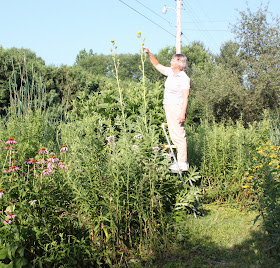I have never been able to make up my mind whether to concentrate on art, writing or natural history. I usually concentrate on one of the three for a while, then concentrate on another of the three. Art, writing and natural history are intwined in my life and often involve teaching a combination of these subjects.
Thursday, July 21, 2011
Our Prairie Patch
Twenty-five years ago, soon after I had begun volunteering at Brukner Nature Center the volunteers went on a prairie tour with Ralph Ramey, who was then working for Glen Helen in Yellow Springs. He took us on a tour of area prairies, Bigelow Prairie Cemetery, Smith Cemetery and others. Since then, Tom and I have had a deep interest in Ohio prairies, the prairie plants, and the many butterflies which are found there.
We in southwestern Ohio were not happy with the excessive amount of rain this spring and now we are not happy about the heat wave. The actual temperature is expected to be 98 degrees today and with the humidity is expected to feel like 104 degrees. But the weather this year has been ideal for prairie plants. The tall ones are over eight feet tall. And all of them have lush foliage and promises of even more blooms than what we are seeing today.
Here you see me standing on a ladder and I am still shorter than the Compass-plant with its yellow flower at the very top. I've been told that the Compass-plant was named by the pioneers traveling west because the plant aligns the edge of its leaves toward the sun which would have made them pointing westward in the afternoons. This adaptation helps the plant conserve moisture within the leaves. Tom took this photo about a week ago.
I took this photo this morning. More of the Compass-plant flowers are open.
If you look again at the first photo you will notice a bushy plant behind the Compass-plant. This is a Cup Plant or Indian Cup(Silphium perfoliatum).
I saw the first blooms on it this morning. The leaves, in sets of two, opposite one another, are united at the base and form a cup that holds water when it rains.
Back to the first photo. In front of the Cup Plant is one of the Big Bluestem(Andropogon gerardii) clumps. This is the predominent grass of the Eastern prairies. The plant is named for the blue color at the joints of its stems which becomes more pronounced as the grass matures. Here is its flowering head. It is sometimes called Turkeyfoot because the flowering heads remind some people of turkey feet.
Other prairie flowers which you can see in the first photo are the Purple Coneflower to the left and the yellow Oxeye to the right. We've had to pamper the Compass-plant a bit to give it a good start but the Purple Coneflower(Echinacea purpurea)...
and the Oxeye or False Sunflower(Heliopsis helianthoides)
grow "like weeds". In fact, one of our former neighbors was enchanted with our prairie flowers until he found out what they were prairie plants. Then he dismissed them with the comment, "Oh, they're just weeds." He didn't like them anymore.
Anything that is as beautiful as a prairie plant is a flower to me. I admire their many adapations, one of which is long, long roots. There is often more plant mass below the ground than above the ground. It's no surprise they grow like weeds and no surprise they thrive when other plants shrivel up and die.









These are gorgeous, Pauline!
ReplyDeleteGorgeous pictures. A lot of your prairie flowers are similar to our grassland flowers in South Africa
ReplyDelete